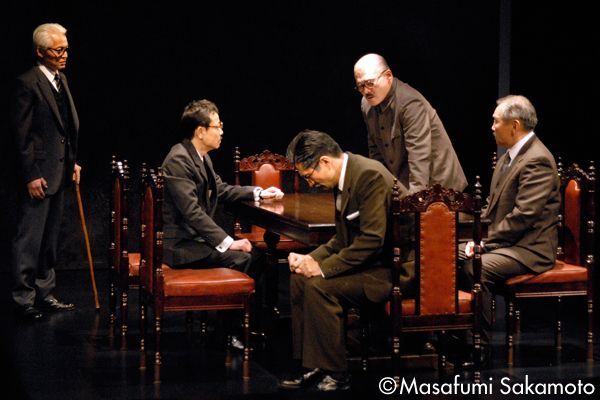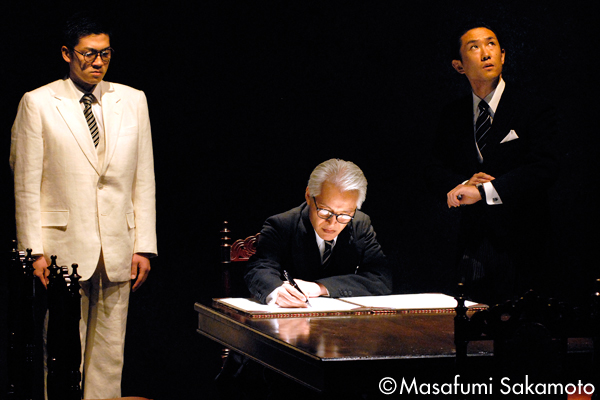Act I, Prologue. The scene is the front chamber of the court at which the International Tribunal for the Far East (commonly known as the Tokyo Trials) on May 3, 1946. Koki Hirota, Yosuke Matsuoka, Shigenori Togo, Mamoru Shigemitsu and Toshio Shiratori are waiting for their trial to begin. As the five former diplomats enter the courtroom the scene shifts to the deck of the US battleship
Missouri
in 1945.
Scene 1. The ceremony for the signing of the truce treaty between Japan and the Allies is taking place on the deck of the US battleship
Missouri
on September 2, 1945. The Foreign Minister Shigemitsu is signing the treaty, accompanied by his secretaries Kase and Ota. Listening to the speech of the Commander in Chief of the Allied Forces, General Douglas McArthur, the three diplomats are full of hopes for the future of Japan, but several hours later a message is received from the Allied Forces General Headquarters saying that the Allies will be establishing a military administration to govern Japan. An enraged Shigemitsu protests vehemently to McArthur and the order is cancelled.
To Shigemitsu, who has just reported the situation to Emperor Hirohito, the Minister of the Interior, Kido insists strongly that he must make sure that his actions do not cause the wrath of the Allies to be pointed at the Emperor.
Scene 2. It is September 12th and the former Foreign Minister Togo is being questioned by the 8th Military Police unit of the American in Yokohama. After his questioning, Togo visits the rooms being rented by the Foreign Ministry in the Imperial Hotel.
When he is stopped by a military guard at the entrance, some quick-witted response by the former Foreign Ministry advisor Saito, who happened to be present, enables Togo to get through. When he meets Kase, Togo is told that, in other places as well, interrogation of war criminals has begun.
After Togo leaves, Saito tells Kase that everyone should begin to think about what past actions they should take responsibility for. Kase begins to think back to the events before the War began. When Shigemitsu returns, Kase makes a proposal to Shigemitsu about the methods they should use for “taking responsibility.”
Scene 3. It is September 16th and a meeting is being held at the Foreign Ministry offices. Shigemitsu tells the people gathered, including the former Prime Minister Hirota, the former ambassador to Italy, Shiratori, the former Foreign Minister Togo and others, that this is a meeting to clarify what each of them had been thinking, what decisions they had made and what actions they had taken as diplomats from the period before the start of the War until after its end. Then he explains that this will help save diplomats who will possibly be accused as war criminals and help provide them with a strategy for the war crimes trials that will surely continue for some time.
As the former Foreign Minister Matsuoka joins the meeting along with Saito, the discussions become more complex. Everyone is moved by Shigemitsu’s words when he says, “If we don’t accept responsibility for our past actions and feel ashamed for what we did while simply hanging our heads in silence, there is no way that the people of this country can pick themselves up and begin to move forward.” Hearing these words, each begins to reflect on the past and their actions [that led to the Japan’s downfall].
The scene is the Japanese embassy in Shanghai in December of 1929. The consul general Shigemitsu reads a letter from [Prime Minister] Hirota suggesting the possibility that Sadao Saburi had been assassinated as a result of a conspiracy concerning China. There, the chief staff officer for strategy of the Kanto Army, Kanji Ishihara, enters and criticizes the Foreign Ministry and the Prime Minister, whose policy is to avoid becoming involved in the internal affairs of China, because they all lack the courage to exert pressure in support of Japan’s interests on the continent. Ishihara threatens that the Kanto Army is ready to take action [independently, if the government doesn’t become more aggressive].
July 1931. The scene is a hotel room in Dalian [Manchuria]. A secret meeting is in progress between Ishihara and the chief of the Foreign Ministry’s intelligence department, Shiratori. It is mentioned that Shigemitsu lost a leg in a bomb incident set up by the [Japanese] military. Even the foreign policy hard-liner Shiratori finds it difficult to accept the military’s outrageous independent actions, and the talks with Ishihara end with no agreement on future policy. Before leaving, Ishihara indicates that the Army will soon be taking military action on its own.
The scene returns to the meeting of the diplomats in 1945. The participants are discussing whether or not the Manchurian Incident [perpetrated by the Japanese Army] that occurred two months after the meeting in Dalian was the real cause leading Japan into the Pacific War. Over the question of whether or not diplomatic actions are the same as military actions in time of war, the opinions of the former diplomats are divided. In the process of the discussions, however, there are glimpses of the way in which the Foreign Ministry had given in to the military.
The scene shifts to February of 1933 at the general assembly meeting of the League of Nations in Geneva, Switzerland. To this assembly where Japan is accused of being responsible for the Manchurian Incident, Matsuoka has been sent as Japan’s ambassador plenipotentiary. In response to the League of Nations’ demand that Japan withdraw from Manchuria, the Japanese government is firmly committed to defending Japan’s interests with its presence in Manchuria. Matsuoka himself believes that Japan should accept the proposal that Manchuria be placed under international control, but he fails to get the Japanese government’s approval. As a result, Matsuoka makes the decision to withdraw from the League of Nations.
Act II, scene 4. Again, the scene returns to 1945 meeting in the Foreign Ministry offices. Shigemitsu is saying that Japan’s withdrawal from the League of Nations was not only the wish of the government and/or the military but also the result of an inability to stem the tide of public opinion. The diplomats look back on their experiences in search of the reasons behind the military’s rise to dominance [in prewar Japan]. Hirota believes with regret that the government’s failure to impose decisive measures to restrict the power of the military in the wake of the “February 26 Incident” [a failed four-day coup d’état attempt by young army officers] laid the foundation for the military to lead Japan into war.
Scene 5. September 1938 at the Japanese Consulate in Berlin. Prior to his appointment as Japan’s ambassador to Great Britain, Shigemitsu is talking to Togo, who has just been relieved of his post as ambassador to Germany [due to the government and military’s dissatisfaction with his policies] and is about to depart to his next assignment in Moscow. Togo’s replacement, the former military man Oshima, who puts his faith in Hitler, suddenly appears and states with conviction his determination to form an alliance between Japan, Italy and Germany as quickly as possible. Togo is outraged and Shigemitsu dismisses the idea [as ridiculous].
The scene shifts to the Japanese Consulate in Rome in May of the following year. Kase has come on behalf of Shigemitsu to visit the Japanese ambassador to Italy, Shiratori. To Shiratori, who believes that Japan must bet its future on the [Axis] alliance with Germany and Italy, Kase explains Shigemitsu’s fear that such an alliance will only lead to further isolation of Japan from the rest of the world. However, the visit does nothing to bring their opinions closer together.
Scene 6. Again, the scene returns to the Foreign Ministry offices in 1945. Matsuoka, as the diplomat who was finally responsible for concluding the Axis alliance agreement, murmurs that it was the biggest blunder of his life. Amid the heavy mood of the meeting, Shigemitsu continues to cite causes from the past that led to the war and to question the reasons behind them. Among the reasons cited for entering the Axis alliance were the worsening of relations with Great Britain and the United States, the invasion of Southeast Asia, the attack on Pearl Harbor, the possibility of impending defeat, and more.
As heated discussion continues between the five former diplomats, each is able to recognize their own “crimes” [against the people of the nation] but they remain unable to find the way to take responsibility for them. To the other four who sit with heads hung, Shigemitsu says, “Let us continue to work from now on to establish Japan as a country that can stand on equal footing with other countries as a member of the world community.”
Epilogue. Just before the diplomats enter the courtroom for the hearings in the International Tribunal for the Far East (Tokyo Trials), Hirota faces Shigemitsu and says, “Someone has to pay with his life. That is what I am here for.” (Hirota later becomes the only civilian official to be executed as a Class A War Criminal) Then he hangs his head in deep sorrow, saying, “To the people of this country, I truly did something unforgiveable.”




